| |
 |
December 2016 |
 |
|
| |
| |
|
Welcome
Welcome to the December issue of the USAPEEC ASEAN Regional Office’s newsletter.
This newsletter seeks to provide readers with useful product and major market information for institutional and consumer users of U.S. poultry. Readers will find in every issue a variety of general market information, program activities as well as useful product information.
This issue, we share several activities that took place in Southeast Asia.
Contents:
- Food shows provide country-wide platform for international companies to introduce their products in Myanmar
- U.S. Deputy Chief of Mission celebrates Thanksgiving in Yangon, Burma
- Poultry cooking competition attracts top culinary talents in Myanmar
- Common seasonings used in poultry dishes
- Poultry alternatives to traditional bacon
- Different types of cuisines in Asia
|
|
|
| |
|
|
|
| |
|
Additional Market Information Available
We have updated our website to include more information on market reports and export documentation guidelines.
You can visit our ASEAN website at: www.usapeecasean.com |
|
|
| |
|
|
|
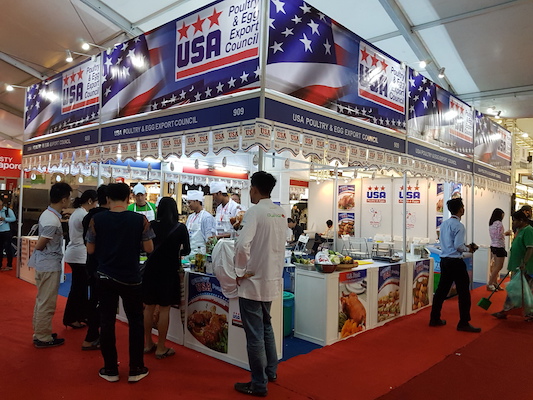 |
|
Food shows provide country-wide platform for international companies to introduce their products in Myanmar The MyanFood 2016 Show took place during 24-26 November, 2016 and attracted the participation of large numbers of international companies and brands eager to introduce their products to consumers and institutional users in the country. Over 280 companies and brands exhibited in the three-day show held at the Mida Ground Expo Hall in Yangon. Country pavilions from China, India, Italy, Malaysia, Singapore, Taiwan, Thailand, and the United States participated in the show. Over 6,000 visitors attended the trade show, featuring a wide range of food products including meat and poultry, confectionery, alcoholic and non-alcoholic products, and bakery products.
USAPEEC ASEAN Region Director, Margaret Say, managed the U.S. Poultry booth which had daily tasting of poultry products prepared in local and western cuisines by a team of chefs in Myanmar. The USAPEEC booth attracted hundreds of trade visitors each day. In addition, USAPEEC was the main sponsor for the Myanmar Poultry Culinary Challenge, which was one of the main highlights of the MyanFood 2016 Show.
|
|
Cross-section of USAPEEC booth at MyanFood 2016 Show |
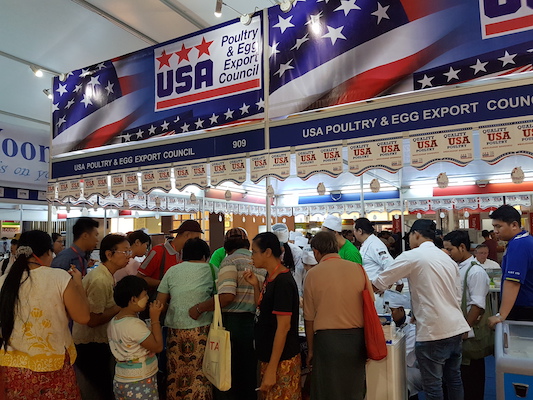 |
Crowd of trade visitors thronging the U.S. poultry booth |
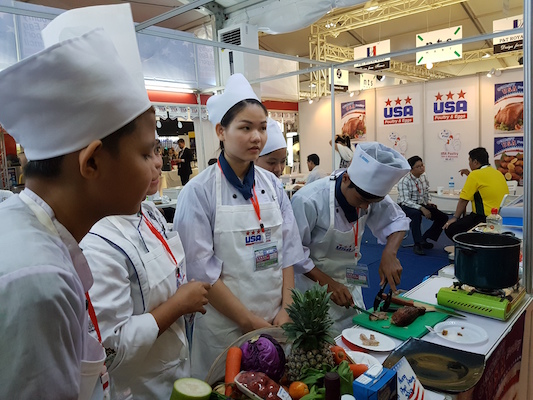 |
Group of assistant chefs preparing poultry dish for taste testing during the show |
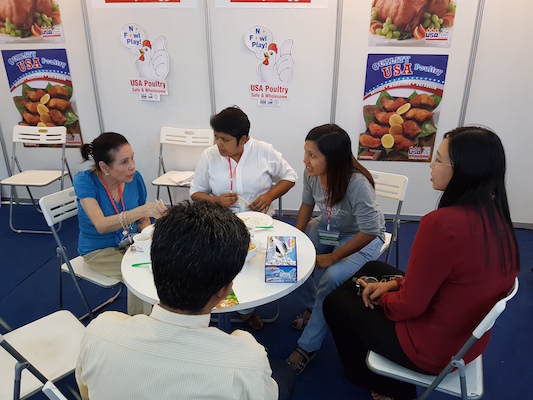 |
Margaret Say, USAPEEC, in discussion with trade visitors during MyanFood 2016 Show |
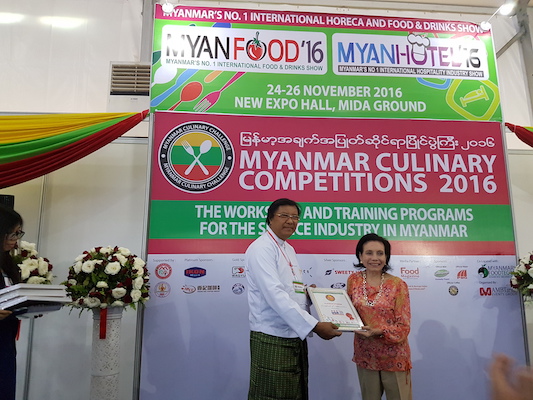 |
Margaret Say, USAPEEC, receives the Best Product Show Award at the MyanFood 2016 Show |
| |
|
|
|
|
|
U.S. Deputy Chief of Mission celebrates Thanksgiving in Yangon, Burma
During the filming of a typical Thanksgiving dinner in her residence by a private television studio, U.S. Deputy Chief of Mission Kristen Bauer explained the origin of Thanksgiving to invited guests and shared some of her fond memories of the event.
DCM Bauer celebrated Thanksgiving in her residence in Yangon, Burma, by sharing a roast turkey, accompanied by potatoes, apples, cheese, and wine with guests. Public Affairs Officer, John Groch, assisted DCM Bauer to prepare the traditional roast turkey for dinner during the Thanksgiving festival celebrated by Americans. |
|
 |
DCM Kristen Bauer, assisted by Public Affairs Officer, John Groch, preparing turkey for dinner |
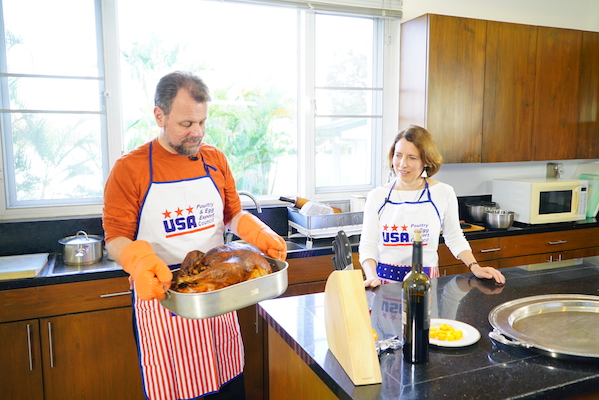 |
Public Affairs Officer Groch shows cooked turkey to DCM Kristen Bauer |
| |
|
|
|
 |
|
Poultry Cooking Competition attracts top culinary talents in Myanmar
The Myanmar Poultry Culinary Challenge was one of the main highlights of the MyanFood 2016 Show. It attracted participation from a number of rising culinary talents from both hotels and independent restaurants.
The Poultry Culinary Challenge is dubbed as Myanmar’s premier cooking competition with eager participation by junior and experienced chefs from leading restaurants. USAPEEC was the Platinum Sponsor for the Poultry Cooking Competition, which had participants using U.S. poultry parts in various dishes. |
|
A participant preparing a poultry dish in the culinary competition |
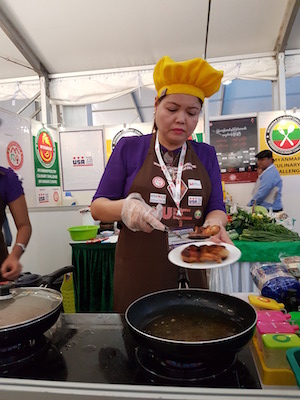 |
One of the contestants in the poultry cooking competition |
 |
Another participant displaying her cooking skills |
| |
|
|
|
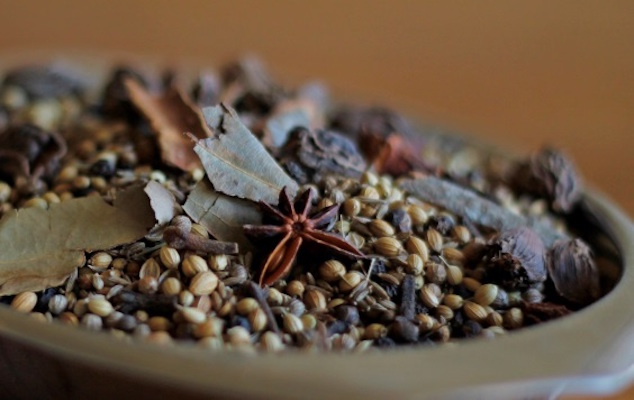 |
|
Common Seasonings Used in Poultry Dishes
Seasoning involves adding salt, herbs or spices to food to improve its flavor or taste. As a significant port, Singapore has dealt with herbs and spices since her early days when playing a vital role in the Spice Trade from the East to West1. Here are three commonly used seasonings in Singapore’s poultry dishes.
1. Salt
Salt is usually used as a preservative2. Before the invention of refrigerator, salt was used to desiccate food such as salted fish. Similar to salt curing, edible salt would be used to rub all over the food, ensuring its proper preservation for future consumption. Salt is also used as a flavoring. A small amount is usually added when food tastes bland. Sea salt helps to tenderize meat such as chicken and beef3. Prior to cooking, salting the meat evenly helps to enhance its texture, juiciness and flavor4.
Other widely known salts are the Himalayan Pink Salt and Kosher Salt5. The Himalayan Pink Salt is harvested in Pakistan. Mined from the second biggest salt mine in the world, the salt is pink in color as it contains iron oxide. It contains smaller amounts of iron, calcium, potassium, and magnesium. Kosher salt has a flaky, coarse structure texture, which makes it efficient in extracting blood from meats. It is a chef’s favorite seasoning since it has bigger flake size, which allows chefs to rub the salt evenly on meats.
2. Coriander
Also known as Chinese parsley in Singapore, coriander is believed to date back to at least 5,000 BC6. The leaves and dried seeds are usually used in cooking whereas the stem is added as a garnish. To achieve the coriander in powdered form, the seeds are dry roasted before putting them in a blender. A dish where this seasoning is commonly used is in one of the local favorite dishes, Ayam Penyet7. Coriander also contains health benefits such as reducing skin inflammation, diarrhea and mouth ulcers8.
3. Nutmeg
This spice is attained from the inner kernel of nutmeg seeds harvested from the Myristica frangan tree found in Banda Islands, Indonesia9. Usually found in ground or powdered form10, nutmeg has a distinctive sweet taste and is currently used in cuisines worldwide. In Singapore, nutmeg is added to dishes such as oxtail soup or roasted chicken. Similar to coriander, nutmeg is also associated with health benefits such as its ability to alleviate pain, boost one’s immune system function, and skin condition11.
Nutmeg is an integral ingredient in certain local cuisines. For instance, Peranakan cuisine represents the symphony of Chinese-Malay culture and uses nutmeg in most of their dishes. Such dishes are Hong Bak (a classy Pork stew), Kiam Chye Ark (duck served in salted mustard soup), and Ngoh Hiang Lor Bak (a five-spiced pork roll).
References:
- Marinabaysands.com. (2016). Herbs and Spices of Singapore. [online] Available at: http://www.marinabaysands.com/restaurants/foodie-guide/herbs-and-spices-of-singapore.html
- Mental Floss. (2016). The Origins of Salt, Pepper & Other Popular Spices. [online] Available at: http://mentalfloss.com/article/20640/origins-salt-pepper-other-popular-spices
- Steamy Kitchen Recipes. (2007). Steak Recipe: How to turn cheap "choice" steaks into "prime" steak. [online] Available at: http://steamykitchen.com/163-how-to-turn-cheap-choice-steaks-into-gucci-prime-steaks.html
- Happyeats.com. (2016). Should You Salt Meat Before Cooking? Yes! | Happy Eats! [online] Available at: http://happyeats.com/should-you-salt-meat-before-cooking-yes/
- Authority Nutrition (2016). Types of Salt. [online] Available at: https://authoritynutrition.com/different-types-of-salt/
- Parkinson, R. (2016). You Say Cilantro, I Say...Coriander? [online] About.com Food. Available at: http://chinesefood.about.com/od/vegetablesrecipes/a/cilantro.htm
- Khoo, H. (2011). Ayam Penyet and sambal recipes. [online] Soshiok.com. Available at: http://www.soshiok.com/recipe/ayam-penyet-and-sambal-recipes
- Organic Facts. (2008). Health Benefits of Coriander | Organic Facts. [online] Available at: https://www.organicfacts.net/health-benefits/herbs-and-spices/health-benefits-of-coriander.html
- Szczepanski, K. (2016). Nutmeg | The Unsavory History of a Tasty Spice. [online] Available at: http://asianhistory.about.com/od/colonialisminasia/p/Nutmeg-Unsavory-History.htm [
- iFood.tv. (2016). Top 5 Spices Of Singapore. [online] Available at: http://ifood.tv/ingredients/404926-top-5-spices-of-singapore
- Organic Facts. (2016). [online] Available at: https://www.organicfacts.net/health-benefits/herbs-and-spices/nutmeg.html
|
|
Credit: Mike |
| |
|
|
|
 |
|
Poultry Alternatives to Traditional Bacon
Bacon is a satisfying breakfast staple for many, and is commonly found in continental breakfast buffets in hotels served alongside sausages and eggs. It is also popular as an ingredient, a topping, and even as a condiment in foods such as sandwiches, sauces, pizzas, salads, and soups. However, the well-loved traditional bacon, which is made out of pork, is often left out of breakfast buffets and many other dishes and restaurants in Southeast Asia out of religious sensitivity.
The good news is that there are halal poultry bacon alternatives to consider when preparing a bacon dish. Swapping out traditional bacon in any recipe for these options can also significantly reduce the calories, cholesterol, and fat content of the dish, serving up a healthier version.
Turkey Bacon
Turkey bacon is probably the most common substitute for traditional bacon. While comparable servings of traditional bacon may contain more nutrients such as protein, zinc, and choline; for dieters, turkey bacon definitely wins out with fewer calories and less fat1. Try using turkey bacon in a salad alongside shredded Brussels sprouts and spinach for an appetizing take on this alternative.
Chicken Bacon
Chicken bacon is by far a healthier choice over traditional pork bacon as it contains less fat and calories. It might also contain more protein per strip than pork bacon (depending on the cut) as chicken is a naturally leaner meat. And if sodium intake is a concern, diners will be happy to know that it might take less salt to cure chicken than pork bacon, making it a better choice for those watching their blood pressure2.
Remember to pay close attention when preparing recipes using chicken bacon; due to its lower fat content and marbling, it is more prone to being burnt or overcooked.
Duck Bacon
Duck bacon is made from thinly sliced smoked duck breast cut thinly lengthwise, and is leaner than the pork belly used in traditional bacon. Duck bacon is salty and full-flavored, and is distinctive enough to be enjoyed on its own, but can also complement other milder flavors in a dish. As with other duck products, beware of overcooking duck bacon. Additionally, as duck meat does not turn crispy with longer cooking times, it works ideally with hors d’oeuvres and other recipes involving bacon-wrapped ingredients such as chicken breasts and scallops.
References:
1 Prevention (2014). Which is healthier: pork bacon vs turkey bacon? [online] Available at: Which Is Healthier: Pork Bacon vs. Turkey Bacon
2 WiseGeek (2016). What is chicken bacon? [online] Available at: http://www.wisegeek.com/what-is-chicken-bacon.htm |
|
Credit: Diana |
| |
|
|
|
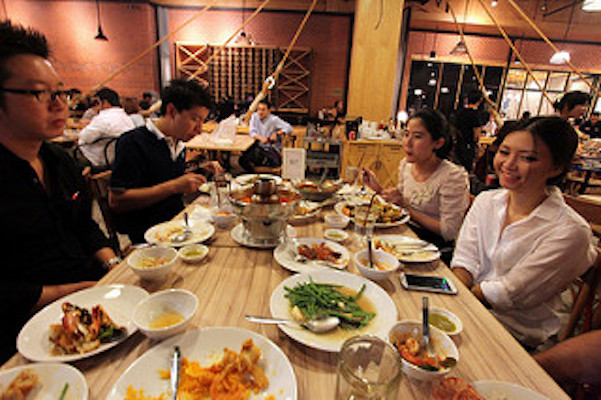 |
|
Different Types of Cuisines in Asia
A cuisine is characterized as a style of cooking practice and tradition that is associated with a specific culture. An Asian cuisine encompasses several major regional cuisines, including Southwest Asia (India, Pakistani and Sri Lanka), Northeast Asia (China, Korea and Japan) and Southeast Asia (Thailand, Laos, Cambodia, Vietnam, Indonesia, Malaysia and Singapore).
In Southeast Asia, there are numerous delectable cuisines. Some of the well-known dishes in Southeast Asia are Thai Green Chicken Curry, Vietnamese Beef Pho Noodles and Malaysian Nasi Lemak.
Gaeng Khiao Wan Gai, better known as Thai Green Chicken Curry, is one of the popular curry dishes in Thai cuisine1. Loved by locals and easily found in many eateries worldwide, this authentic Thai dish is scrumptious. Curry is a staple dish in Thailand2. It is prepared by combining fresh vegetables with meat. Boneless chicken is commonly used when concocting this curry dish. This famous curry dish forms a healthy part of the Thai diet, as it is high in vitamins and rich in protein3. There also plenty of other alternatives used instead of chicken, such as prawns, beef and pork. Many would have assumed that green curry will be less spicy as compared to red curry. On the contrary, green curry is just as spicy as red curry, but the sweetness oozing from this dish balances the heat. The ready-made paste to make Thai Green Chicken Curry can be purchased from major supermarkets. This curry is best served piping hot with a bowl of steamed jasmine rice.
Vietnamese Pho serves a bowl of linguine-shaped rice noodles called banh pho, fresh herbs and tender slices of beef in a tasty beef broth. There are instances where slim cuts of beef, such as steak, flank and brisket, are used in this dish. The beef broth is created by simmering beef bones with spices and herbs. Chickens can be also used as an alternative to beef. Some of the nutrients that can be found in this dish are iron, vitamin C and calcium4. It is a popular street food in Vietnam and a specialty dish found globally in many restaurants serving Asian cuisine5. According to villagers, the locals have been consuming this staple dish long before the French colonial period. As relations between the United States and Vietnam improved during the 1990s, this appetizing dish becomes more widely spread to the US and on to the rest of the world6. Vietnamese Beef Pho Noodle is listed as one of the “World’s 50 Most Delicious Foods” by CNN Go in 20117.
Malaysian Nasi Lemak is a fragrant rice dish, soaked in rich coconut milk with pandan leaves and steamed. It is typically served with anchovies, crunchy peanuts, sunny-side up egg, traditional chilli paste, sliced cucumber and fish. It is Malaysia’s national dish and has become very popular throughout Southeast Asia8. The variations to this dish are endless – some would add lamb curry, barbequed squid, fried chicken wings, fried chicken cutlets and omelettes etc. This mouth-watering dish is also a good source of protein and fibre. Nasi Lemak is recently highlighted in the “Top 10 Healthy Breakfasts” by TIME Magazine earlier in this year9.
References:
1 Temple of Thai (2016). What is Thai curry? [online] Available at: http://www.templeofthai.com/cooking/about_thai_curry.php
2 Temple of Thai (2016). Staples of Thai Cuisine. [online] Available at: http://www.templeofthai.com/cooking/staple-thai-cuisine.php
3 Calorie Count (2016). Thai Green Curry. [online] Available at: https://www.caloriecount.com/thai-chicken-curry-recipe-r11732
4 Calorie Count (2016). Vietnamese Pho. [online] Available at: https://www.caloriecount.com/vietnamese-pho-recipe-r28900
5 Viet Street Food (2012). 10 Vietnamese foods we can’t live without. [online] Available at: http://www.vietstreetfood.com/2012/07/10-vietnamese-street-foods-we-cant-live.html
6 Lucky Peach (2016). The history of Pho. [online] Available at: http://luckypeach.com/the-history-of-pho-andrea-nguyen/
7 CNN Go (2011). World’s 50 Most Delicious Foods. [online] Available at: http://travel.cnn.com/explorations/eat/readers-choice-worlds-50-most-delicious-foods-012321/
8 Yes To Travel (2015). Nasi Lemak: The Malaysian National Dish. [online] Available at: http://www.yestotravelblog.com/2015/08/nasi-lemak-malaysian-national-dish.html
9 Time Magazine (2016). 10 Healthy Breakfasts. [online] Available at: http://time.com/4254125/healthy-international-breakfast/ |
|
Credit: Dave Learn |
|
Disclaimer: All opinions and views expressed in the articles published in the newsletter are those of the individual journalists and do not necessarily reflect those of the publisher, the newsletter's sponsors or USA Poultry & Egg Export Council.
You have received this email because you have registered to get newsletters from USAPEEC ASEAN.
If you prefer not to receive these updates, please
click here
to unsubscribe.
Do not reply to this email. For enquiries, go to www.usapeecasean.com
® USA POULTRY & EGG EXPORT COUNCIL
541 Orchard Road, #15-04, Liat Towers, Singapore 238881 Tel: (65) 67371726 Fax: (65) 67371727
*|REWARDS|* |
|
|
|